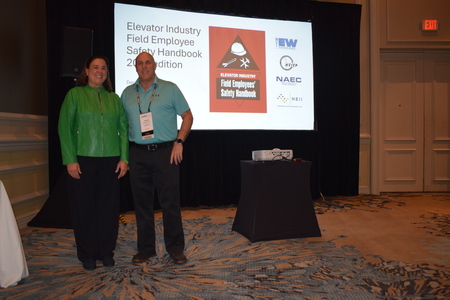Elevating Industry Safety
Jul 1, 2025

The 2025 edition of the Elevator Industry Field Employees’ Safety Handbook is a critical step in reinforcing the industry’s unwavering commitment to worker safety.
by Dot Mynahan
In an industry where safety is paramount, the release of the 2025 Elevator Industry Field Employees’ Safety Handbook marks a significant milestone. This latest edition, a collaborative effort by Elevator World, Inc., the National Association of Elevator Contractors (NAEC), the National Elevator Industry Education Program (NEIEP) and the National Elevator Industry, Inc. (NEII), underscores the industry’s unwavering commitment to the well-being of its workforce.
A Comprehensive Overhaul
Spanning 220 pages, the 2025 Handbook is more than just an update; it’s a comprehensive overhaul designed to address the evolving challenges faced by elevator industry professionals. Notably, it introduces a new section on Mental Health and Well-Being (Section 21). This content is critically important given the construction industry’s suicide rate is four times that of the general population. Employees struggling with mental health challenges like stress, anxiety or depression can have impaired decision making, reaction times and awareness, which can increase the likelihood of accidents or mistakes. This new section of the Handbook provides an important list of crisis hotlines that can be used nationwide to help with suicide prevention, substance abuse issues and family-related challenges like caregiver support, child abuse or domestic violence. Finally, the section provides information adapted from Occupational Safety and Health Administration (OSHA) publication 4446-2024 titled “Suicide Prevention in Construction: 5 Things You Should Know.”
The Handbook’s new content also includes a Re-roping Pre-Start Checklist (Section 23.4), which covers everything from job preparation and method selection to hoisting and rigging and Personal Protective Equipment (PPE). Re-roping is one of the industry’s highest risk tasks. It is critically important to make sure everyone from the supervisor to the apprentice is aligned and trained in the method being used for that job, and the team is set up with the proper tooling and rigging to perform the work safely. The layout of the checklist over two pages ensures it will be easy to copy for repeated use by industry repair teams.
For the first time, the industry’s 9 Safety Absolutes are highlighted in the Index, as well as in the content of each applicable section. According to David Smarte, global education and safety officer for NAEC:
“This updated version aligns with the best practices being developed by the OSHA Alliance, a group of elevator industry experts partnering with OSHA to foster safety and health practices and programs to improve industry safety.”
Members of the OSHA Alliance include the Elevator Contractors of America (ECA), the Elevator Industry Work Preservation Fund (EIWPF), the International Union of Elevator Constructors (IUEC), NAEC and NEII. You can find their published “Best Practices for Electrical Safe Work Practices, Hoisting and Rigging and Jumpers” – as well as new hire training and OSHA 10- and 30-h content geared to the elevator industry – by visiting the Alliance’s website: elevatorindustrysafetypartners.com.
The Safety Handbook Working Group also addressed safety topics being addressed at the state level across America, specifically Heat Illness (Section 14.13) and Workplace Violence (Section 1.4). Six states have adopted heat standards and seven more have heat standards in development. OSHA has a Proposed Rule for Heat Injury and Illness Prevention in Outdoor and Indoor Work Settings. While there are variations in the content of each of these standards, the Working Group aligned on the commonalities between these programs to develop the new content. Similar efforts across states are underway regarding workplace violence, with California enacting the most robust laws. While previous editions of the Handbook addressed unacceptable behaviors, the new Workplace Violence section clearly defines prohibited conduct and establishes reporting procedures.
Finally, the Beams section of the Handbook has had all timber reference charts removed, the steel beam reference chart has been modified and a new aluminum beam reference chart has been added.
In addition to the new content, all of the other sections of the Handbook were reviewed and updated. Major revisions were made to Lockout/Tagout (Section 7) to align with the best practice being developed by the OSHA Alliance. This includes “live-dead-live” checks to ensure power has been fully removed from the equipment; the use of the term “company lock” versus “group lock” to refer to a lock being left on equipment once the mechanic has left the job; and machine-room-less (MRL) car movement locking devices. Similar updates were made to car top and pit access procedures in Section 8 to align with the best practices being developed by the OSHA Alliance.
Section 11 was overhauled and renamed Moving Work Platforms to help clarify the differences between three different types of moving work platforms: running platforms, temporary movable work platforms and false cars. Illustrations and descriptions for each configuration were added to the Handbook as well.
Section 14.12, Silica, was updated to align with OSHA’s Construction Industry Standard to protect workers from exposure to respirable crystalline silica. This revised section includes a sample assessment form companies can use to assess the level of exposure to silica based on the tasks being performed, as well as explaining the three different levels of control that can be used for protection: engineering controls, work practices or PPE.
Finally, we quadrupled the content in Escalators and Moving Walks (Section 16) to address topics such as customer communications, general safety rules, removing floor/deck plates, Lockout/Tagout, removable controllers, pit access, step removal and working in the truss.
Raising Awareness
In recent months, Smarte and your author have had the pleasure to present Handbook updates at several industry-related conferences across the U.S., and the feedback has been overwhelmingly positive. We encourage all users of the Handbook to reach out to us with feedback on the new edition or suggestions for content in the next edition.
Finally, an exciting new feature being offered this year is the ability to customize the cover of the Handbook to include your company’s logo. Pricing for modifications and customized copies can be coordinated with Susan Crigler at ELEVATOR WORLD.
To purchase the latest edition in print or digital format for only US$18, elevator industry personnel can go to elevatorbooks.com. It is available in English and will soon be available in Spanish. A Canadian edition will be available soon in both English and French.
Get more of Elevator World. Sign up for our free e-newsletter.









